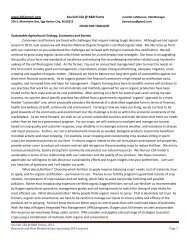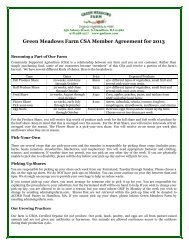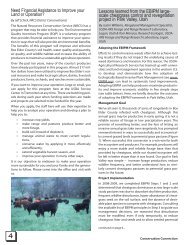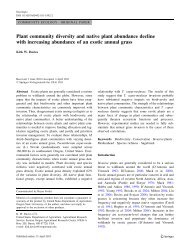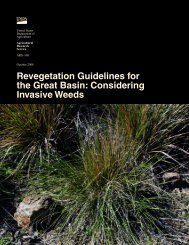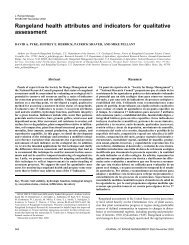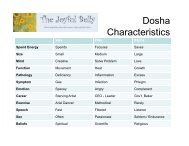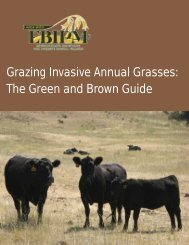Exotic Plant Management in California Annual Grasslands
Exotic Plant Management in California Annual Grasslands
Exotic Plant Management in California Annual Grasslands
You also want an ePaper? Increase the reach of your titles
YUMPU automatically turns print PDFs into web optimized ePapers that Google loves.
grassland fires (Sweet 2005). For perennial or herbaceousplants with protected meristems (e.g., rosettes or rhizomes),the burn must be hot enough to damage the vegetative reproductivetissues and prevent resprout<strong>in</strong>g. For this reason, prescribedburn<strong>in</strong>g is rarely effective for the management ofperennials and <strong>in</strong> most cases can stimulate their growth(DiTomaso et al. 1999a). It has, however, been used to reducethe seed bank of French broom with<strong>in</strong> <strong>California</strong> grasslandsett<strong>in</strong>gs (Alexander and D’Antonio 2003b). Fire stimulatesbroom seed germ<strong>in</strong>ation, and the flush of seedl<strong>in</strong>gs is thencut, treated with an herbicide, or reburned prior to plantsbecom<strong>in</strong>g reproductively mature.<strong>Annual</strong> species that are most susceptible to control withprescribed burn<strong>in</strong>g are those that produce seeds after the fireseason beg<strong>in</strong>s, have flower<strong>in</strong>g structures either embeddedwith<strong>in</strong> the fuel bed or exposed to direct flames, and haveshort-lived seed banks. For control of these late-season annualgrasses and forbs, the tim<strong>in</strong>g of the burns is critical. Burns conductedbefore the target species have fully cured their seedsare most effective (Brooks 2001). To be successful, however,f<strong>in</strong>e fuels to carry the fire should not be limit<strong>in</strong>g. However, f<strong>in</strong>efuels are often patchy across landscapes, and the result is amosaic burn pattern that results <strong>in</strong> variable weed control.Invasive grasses with long-awned seeds (e.g., medusahead,downy brome, ripgut brome, red brome, and barb goatgrass)rely on animal dispersal. In many of these species, the seedsrema<strong>in</strong> <strong>in</strong> the <strong>in</strong>florescence longer than most desirablegrasses, and, as a result, they are more susceptible to destructionby the direct heat of burn<strong>in</strong>g (Dahl and Tisdale 1975,Young et al. 1970). Effective control of medusahead with prescribedburn<strong>in</strong>g (more than 90%) was demonstrated as farback as 1953 (Furbush 1953) and has been demonstrated ona number of other occasions (George 1992; McKell et al. 1962;Pollak and Kan 1998; Sharp et al. 1957; Betts 2003; DiTomasoet al., unpublished). However, <strong>in</strong> some cases burn<strong>in</strong>g has notproven successful on medusahead. Young et al. (1972) foundthat repeated annual burn<strong>in</strong>g <strong>in</strong> mid-summer <strong>in</strong>creasedmedusahead <strong>in</strong>festations while decreas<strong>in</strong>g the population ofmore desirable annual grasses. This <strong>in</strong>consistency is probablydue to differences <strong>in</strong> the length of flame exposure and to theheat of the burn. Other <strong>in</strong>vasive long-awned annual grasses,<strong>in</strong>clud<strong>in</strong>g barb goatgrass (DiTomaso et al. 2001; Hopk<strong>in</strong>sonet al. 1999) and ripgut brome (DiTomaso et al. 1999a; Kyserand DiTomaso 2002) have also been controlled with one ormultiple years of burn<strong>in</strong>g, although exception can also befound (A. Lev<strong>in</strong>e and C. D’Antonio, unpublished data). Incontrast, downy brome and red brome are difficult to controlwith burn<strong>in</strong>g because their seedheads beg<strong>in</strong> to shatter and theseeds fall to the soil surface before enough fuel is available(Brooks 2002; Young and Evans 1978).Late season forbs, particularly yellow starthistle, can alsobe controlled by repeated early summer burns (DiTomasoet al. 1999a; Kyser and DiTomaso 2002). Because the seed ofstarthistle survives for more than two years <strong>in</strong> the soil andgerm<strong>in</strong>ation is enhanced by a preced<strong>in</strong>g burn (DiTomasoand Kyser, unpublished data), a s<strong>in</strong>gle year of burn<strong>in</strong>g willnot control an <strong>in</strong>festation. In one case, three consecutive yearsof burn<strong>in</strong>g were required to reduce the yellow starthistleseed bank by 99% (DiTomaso et al. 1999a). In other studies(DiTomaso and Kyser, unpublished data; Miller 2003), <strong>in</strong>tegrat<strong>in</strong>ga first year burn with a second year herbicide treatmentwas the most effective strategy.Like other control strategies, prescribed burn<strong>in</strong>g requires afollow-up program to prevent escaped or isolated plants fromcomplet<strong>in</strong>g their life cycle. Where the seed bank is shortlived,a follow-up program may take only a couple of years;<strong>in</strong> other cases, it may take longer.S<strong>in</strong>ce multiple burns are not usually practical or permitted,and fuel loads may not be sufficient to allow multiple yearburns, <strong>in</strong>tegrated approaches are often more appropriatethan us<strong>in</strong>g burn<strong>in</strong>g as a sole control option.RevegetationThe goal of grassland management should be to improvedegraded communities and make them less susceptible tonoxious weed <strong>in</strong>vasion. Revegetation with desirable andcompetitive plant species is one approach to achiev<strong>in</strong>g longterm,susta<strong>in</strong>able suppression of weed population growth,while provid<strong>in</strong>g high forage production or desirable plantdiversity (Borman et al. 1991; Lym and Tober 1997).The choice of species used <strong>in</strong> a revegetation effort is criticalto its success. Seeded species need to be adapted to the soilconditions, elevation, climate, and precipitation level of thesite (Jacobs et al. 1999). Only a limited number of specieshave proven to be aggressive enough to resist establishmentof problematic <strong>in</strong>vasive species, and the proper species choicevaries depend<strong>in</strong>g on the location and objective. Perennialbunchgrasses are among the most commonly used species forrevegetat<strong>in</strong>g western rangelands and grasslands, and theyhave been shown to reduce the growth and reproduction ofweeds such as yellow starthistle (Lym and Tober 1997; Rochéet al. 1994; Dukes 2001a; Reever Morghan and Rice 2005).Some native broadleaves, <strong>in</strong>clud<strong>in</strong>g Hemizonia congesta, havea similar life cycle to and can suppress the growth of yellowstarthistle (Duke 2001a). Introduced broadleaf species such aslegumes can also be used <strong>in</strong> revegetation programs to suppressrangeland or grassland weeds. For example, Thomsenet al. (1997) and Thomas (1996, 1997) tested several legumespecies for their competitive effect on yellow starthistle.Thomsen et al. (1997) found subterranean clover (Trifoliumsubterraneum) varieties to be the most competitive when comb<strong>in</strong>edwith graz<strong>in</strong>g and mow<strong>in</strong>g, but they did not provideadequate seasonal control of yellow starthistle <strong>in</strong> the absenceof other control options. Thomas (1996, 1997), however,used a comb<strong>in</strong>ation of subterranean clover and/or crimsonclover (Trifolium <strong>in</strong>carnatum) as a cover crop <strong>in</strong> yellowstarthistle–<strong>in</strong>fested pasture. In a completely <strong>in</strong>fested field, hereported an 80–90% reduction <strong>in</strong> yellow starthistle one yearafter plant<strong>in</strong>g with crimson clover. However, use of legumesmay <strong>in</strong>crease soil nitrogen, which can cause other potentiallyundesirable effects (see Dukes and Shaw, Chapter 19).EXOTIC PLANT MANAGEMENT 293



